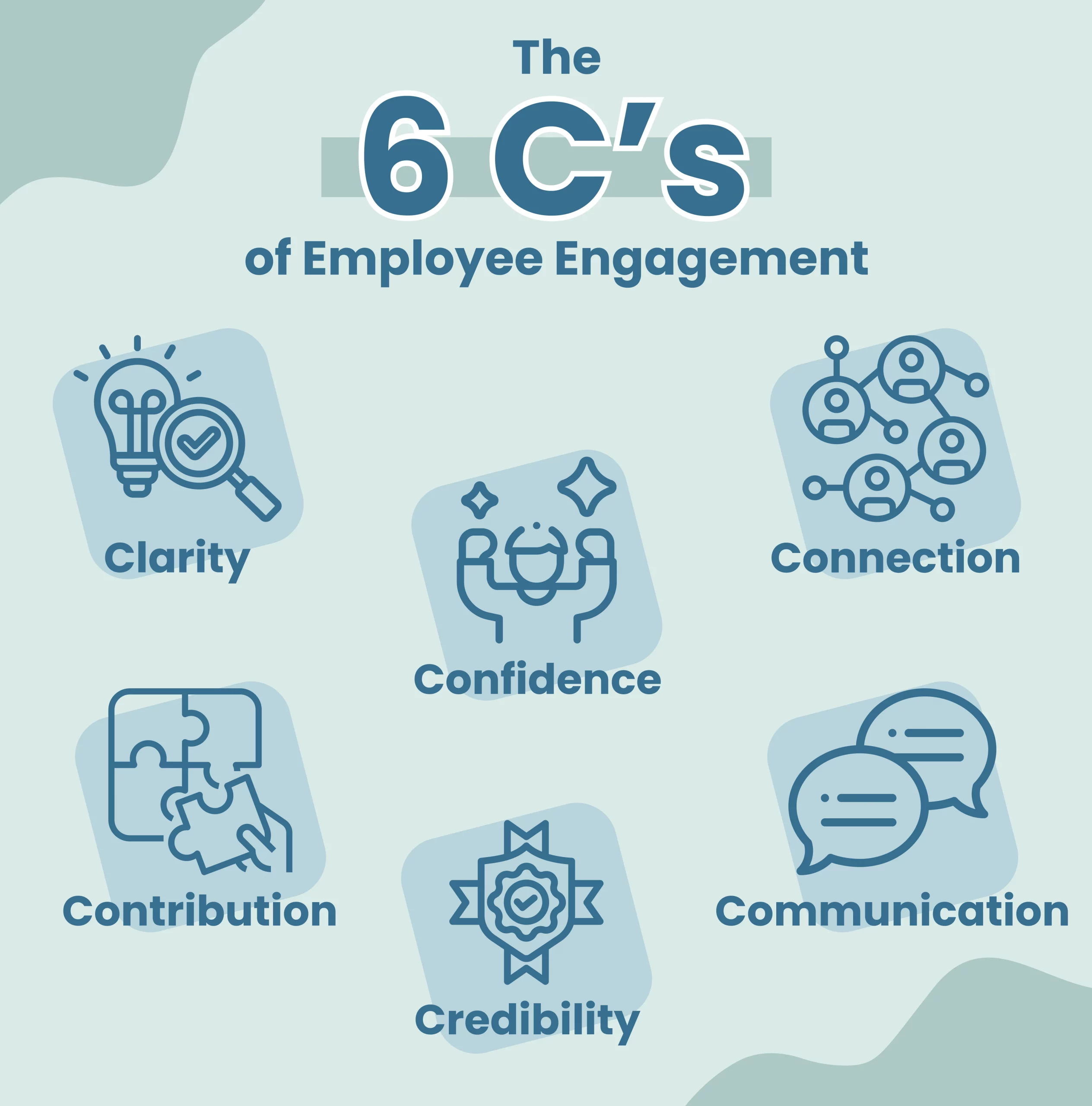Table of content
This brings us to the question: why is employee engagement important? The simple answer is that engaged employees lead to higher productivity, better customer service, and lower turnover rates. Companies often rely on a framework known as the 6 C’s of employee engagement to foster this engagement.
The 6 C’s of Employee Engagement
The 6 C’s are a comprehensive framework designed to create a workplace where employees feel valued, motivated, and involved. Each “C” represents a crucial aspect that, when addressed, contributes to an overall improvement in employee engagement and productivity.
Clarity
Clarity is the foundation of employee engagement. Employees can focus better on their tasks when they understand their roles, responsibilities, and expectations. A lack of clarity often leads to confusion, frustration, and disengagement.
Managers should provide clear job descriptions, regular feedback, and specific performance goals to enhance clarity. When employees know what’s expected of them, they are more likely to feel confident and engaged.
Confidence
Confidence is key to employee performance. When employees believe in their abilities and feel supported by their leaders, they are more likely to excel. Confidence helps them take on challenges and contribute to the company’s goals.
Building confidence requires providing consistent training opportunities, recognizing achievements, and offering constructive feedback. It is also important to create a supportive environment where employees feel their skills are acknowledged and valued.
Connection
Connection refers to the relationships employees form within the workplace. A strong connection to colleagues and the company fosters collaboration, creativity, and morale.
To improve connection, employers should encourage team-building activities, foster open communication, and create opportunities for employees to interact across departments. Employees who feel connected are more likely to stay engaged and contribute to the company’s success.
Contribution
Contribution is all about empowering employees to make meaningful impacts. Employees who feel that their work directly contributes to the company’s success develop a deeper sense of purpose and fulfilment.
Encouraging employees to contribute starts with recognizing and providing opportunities to use their unique strengths. Leadership can foster contribution by allowing employees to take ownership of projects, sharing decision-making power, and offering platforms for their voices to be heard. When employees see that their efforts matter, they become more engaged and motivated.
Credibility
Credibility between leadership and employees is built on trust and transparency. Employees want to know that the company operates with integrity and that their leaders are reliable. Credibility fosters a positive workplace environment where employees feel respected and safe.
Building credibility starts with clear, honest communication from management. Leaders should share company goals, be transparent about challenges, and uphold promises. Consistent actions from leadership that align with company values solidify employee trust and engagement.
Communication
Communication is perhaps the most critical of the C’s because it underpins all other aspects of employee engagement. Open, two-way communication between management and employees is vital to fostering engagement. Employees should feel comfortable sharing their ideas, concerns, and feedback without fear of being dismissed.
Effective communication involves listening to employees and responding to their needs. This can be facilitated through regular check-ins, anonymous surveys, open-door policies, and digital communication platforms. Strong communication helps employees stay informed, feel heard, and remain connected to the company’s mission.
Conclusion
The 6 C’s of employee engagement—clarity, Confidence, Connection, Contribution, Credibility, and Communication—are the pillars that support a highly engaged workforce. By focusing on these core elements, companies can cultivate a culture where employees feel valued, trusted, and motivated. The benefits of a well-engaged workforce are clear: higher productivity, greater innovation, and increased loyalty.
Companies must take a proactive approach to build lasting engagement, ensuring that each “C” is integrated into their workplace strategy. Whether through clear communication, building strong connections, or empowering employees to contribute meaningfully, prioritizing these C’s will lead to long-term success.
FAQs
- What is employee engagement, and why is it important?
Employee engagement refers to the level of emotional connection and commitment that employees have towards their organization. It’s important because engaged employees are more productive, loyal, and motivated, leading to better performance and lower turnover rates.
- How do the 6 C’s improve employee satisfaction?
The 6 C’s—Clarity, Confidence, Connection, Contribution, Credibility, and Communication—address fundamental needs that drive employee satisfaction. When these areas are prioritized, employees feel more valued, trusted, and motivated, leading to higher satisfaction levels.
- How can businesses implement the 6 C’s effectively?
To implement the 6 C’s, businesses should start by assessing their current workplace culture and identifying gaps in engagement. From there, they can improve clarity through clear expectations, boost confidence with training programs, foster connections through team-building activities, and more. Consistent evaluation and adjustment are key to maintaining engagement.
- What are the most common barriers to employee engagement?
Common barriers include lack of communication, unclear expectations, poor leadership, limited opportunities for growth, and low morale. Addressing these barriers by focusing on the 6 C’s can significantly improve employee engagement.
- Can employee engagement improve retention rates?
Yes, employee engagement is directly linked to retention. Engaged employees are likelier to stay with their company because they feel valued and connected to its mission. This reduces turnover and the associated costs of hiring and training new employees.

